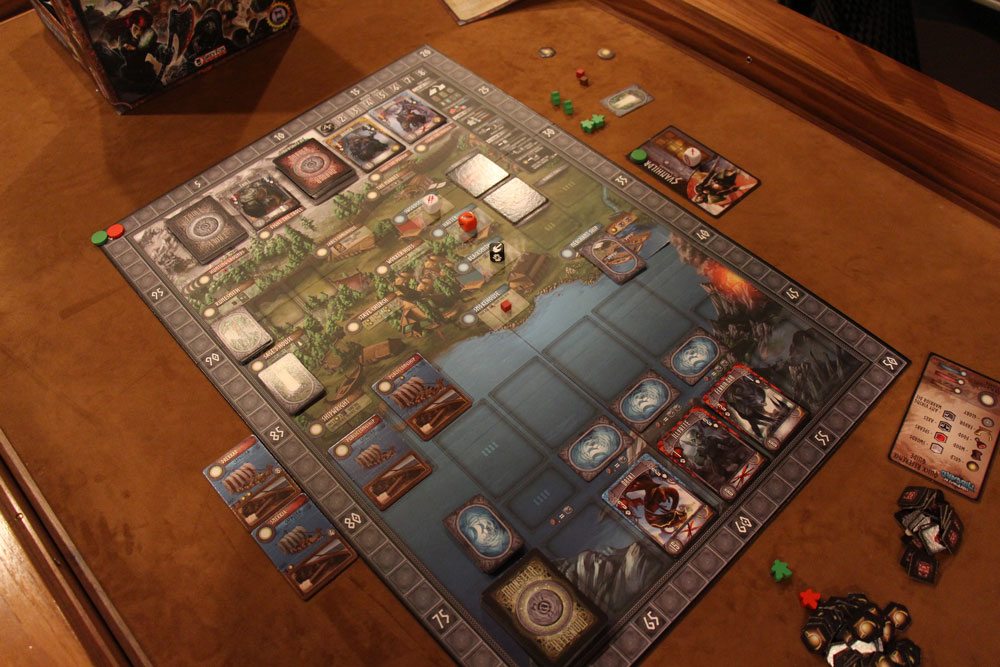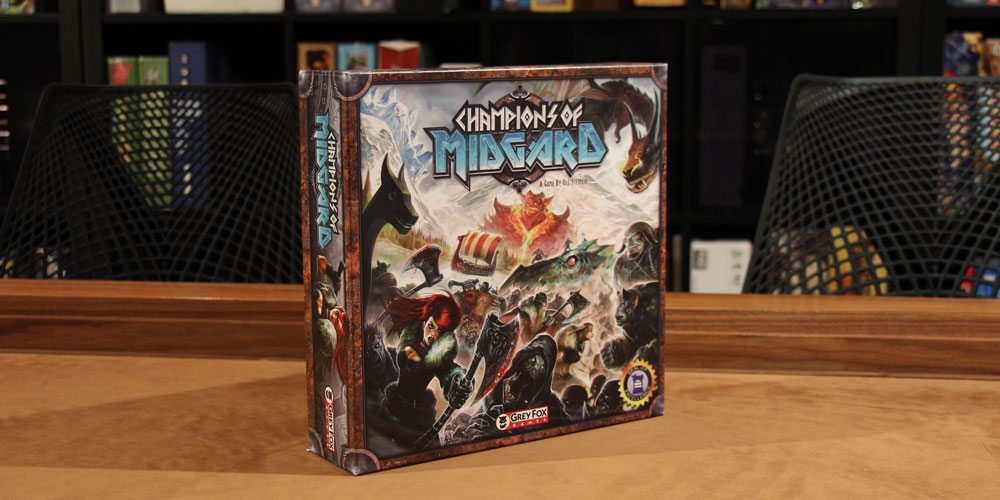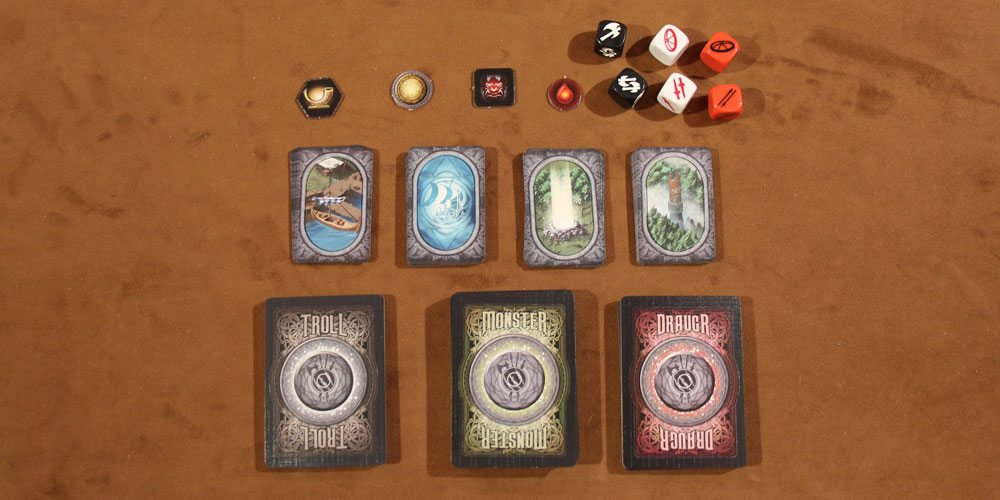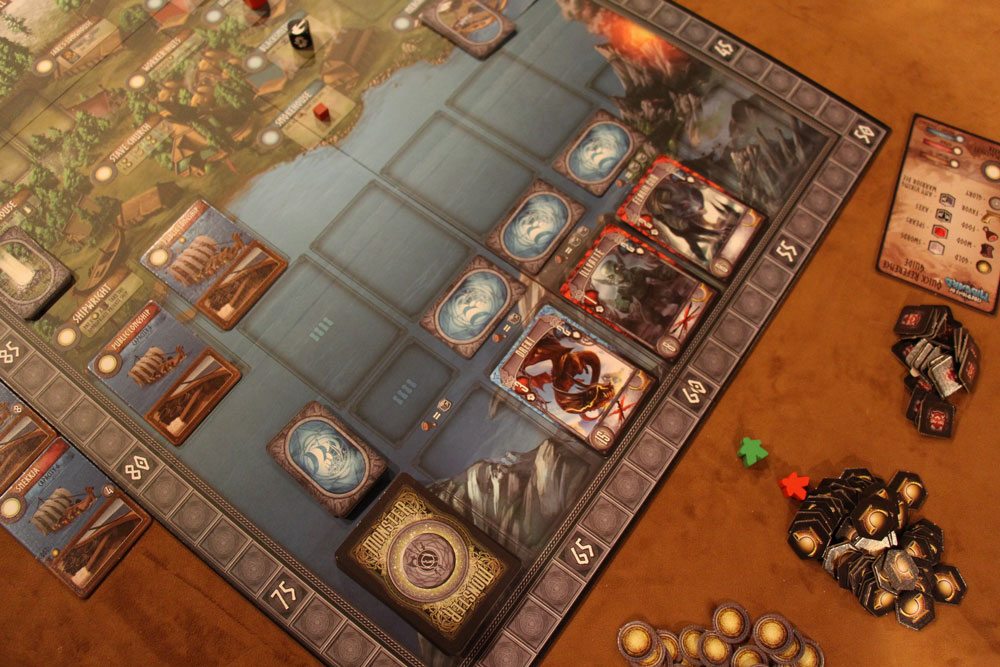“The Jarl of Trondheim has died. Without strong leadership, his prosperous port has fallen into a state of catastrophe. Fearsome creatures have sensed this weakness in Midgard and are coming in droves, driving chaos and destruction before them. Trolls attack the town. Draugr terrorize nearby villages. Monsters strike at travelers and merchants alike. The people are suffering and they need a champion.
In Champions of Midgard, you are a Viking Leader who seeks to gain Glory for your clan and fill the boots of the old Jarl. Defeat the Trolls to keep the townsfolk on your side. Slay Draugr to earn gold to fund your journeys. Kill Monsters in their lairs to gain Glory and the Favor of the Gods. By defeating these epic creatures, you will prove yourself worthy to become the new Jarl and be heralded as the Champion of Midgard!”
– from the rulebook introduction
Summary
Champions of Midgard is a mid-weight worker placement game by Ole Steiness (Police Precinct) for 2-4 players and playing in about 60 minutes. The game has a Viking theme and requires players to recruit Viking Warriors; the resources to feed, inspire, and move them; and rolling dice to battle mythical monsters of Viking lore.
Components
The components are top quality, which is nice considering that the game’s publisher, Grey Fox Games, is relatively new on the scene. (Grey Fox also publishes Captain’s Wager, Draco Magi, and Run, Fight, or Die!, which Jonathan Liu has already reviewed.) In addition to a nice, oversized game board, all of the cardboard is of excellent, thick quality, and punches easily. The cards are equally good and there are a few dozen custom dice, making for a significant amount of high-quality components.
In the box, you’ll find:
- 1 Game board
- 5 Viking Leader boards
- 8 Market stall tiles
- 20 Worker meeples
- 1 Round marker
- 1 Starting player marker
- 1 Small public longship tile
- 1 Large public longship tile
- 4 Private longships
- 8 Player color markers
- 10 Rune cards
- 8 Merchant ship cards
- 18 Journey cards
- 36 Monster cards
- 12 Destiny cards
- 16 Troll cards
- 21 Draugr cards
- 20 Wood cubes
- 30 Food cubes
- 60 Coin tokens
- 3 Damage tokens
- 54 Favor tokens
- 28 Blame tokens
- 34 Viking Warrior dice (12 Swordsmen (white), 12 Spearmen (red), and 10 Axemen(black))

Setup and Gameplay
Setup is a mostly a breeze, thanks to a two-page, step-by-step layout that walks you through setting the game up for 2, 3, or 4 players. There are a number of cards and tiles whose number vary based on the number of players in the game. Some of the setup requires a bit of guesswork, but more on that later.
Cards are placed at various places on the board that are readily apparent, tiles are placed or handed out, other components, like coins, glory, dice, and other resources are placed near the board. Players each choose a Viking Leader board to represent them. Each Leader grants a special benefit and the mat provides a home for the Warriors the Leader has recruited (no more than eight total of Swordsmen, Spearmen, or Axemen). Additionally, each player gets a scant number of resources to begin and a random Destiny card, which has a hidden objective to complete before the end of the game.
Everything in its place, gameplay is ready to begin. The game takes place over eight rounds, and each round involves four basic phases: worker placement, Viking Warrior assignment, combat resolution, and board clean-up. Each player has three workers to begin with (4 in a two-player game) and there is an abundance of places to assign them. In case you lose your place in the game, there is a nice, double-sided player aid, as well as a helpful diagram on the board to remind of what cards and tokens mean and the order of play.
Each round, a troll attacks the harbor town and a player can choose to fight the troll. Additionally, players can decide to fight one of two Draugrs on the outskirts of the village or rent or buy a longship to sail to distant shores to fight legendary monsters. Most of these battles will bring Glory to the Viking Leader and the village.
Troll and Draugr battles take place close to home, so require no resources outside of Viking Warriors. Monster fights take place across the sea, so food must be packed into boats to feed Warriors for their journey. Resultantly, Monster battles usually come deeper into the game, after players have stockpiled food stores. Longships must be bought or borrowed for these journeys. Purchasing a ship involves a trip to the Shipwright, an additional action, but the ship is yours for the duration of the game and pays a Glory bonus at the end of the game.
Food can be acquired in several ways. First is through the Smokehouse, which gets refilled at the beginning of each round. (Like the Swordsmith, Hafter, and Blacksmith, which provide–respectively–Swordsmen, Spearmen, and Axemen, if no one visits the Smokehouse or one of these other locations, they begin to stack additional resources if no one visits them during the previous round.)
Food can also be traded for at the market, exchanging coins or Glory for food or it can be occasionally be purchased from visiting Merchant ships, which change from round to round. Finally, Viking Leaders can assign Viking Warriors to the Hunting Grounds to look for food. This last choice involves assigning dice to the Hunting Grounds, the only place on the board that more than one player can use in a round. Players roll their assigned dice and get food (to a maximum of six cubes), depending on their dice rolls. It’s very possible that they see no game and come up empty (blank rolls).
The remaining worker placement choices involve going to he Jarl’s longhouse to gain a Swordsman and the first player token, or visiting the Worker’s Huts to pay to acquire one additional worker. The payment for this benefit is on a decreasing scale with the first player to take this action paying more than each subsequent player. Players can also stop by the Stave Church to spend coins to buy Glory, the Sage’s House to get an additional Destiny card and peek at one of the facedown Journey cards (see combat resolution, below), or the Runesmith to pay a Wood resource to receive a Rune. Rune cards grant additional one-time benefits and receive game-end bonuses.
Some of these choices require Viking Leaders to assign the Viking Warriors they have recruited to their Leader mat. These are next assigned to fight Trolls, Draugr, or to ships on their way to fight Monsters. What’s more, some enemies carry an icon indicating that certain Warriors can’t be used to fight them in battle, so these must be respected.
The first battle involves the Troll, since he is trying to knock down the walls each round. The player battling the Troll rolls the Viking Warrior dice assigned to the Troll card. If unhappy with the roll, he may spend a Glory token to reroll some or all of the dice. Swordsmen and Spearmen dice have a combination of blank (miss), single weapon, double weapon, and shield faces. Axemen have single, double, and blank faces. To defeat the Troll, the Warrior dice weapons must meet or exceed the Troll’s defense value. Combat occurs simultaneously, so the Troll also deals damage, killing a number of Warriors, which are removed from the Leader’s supply. Shields can reduce or negate this damage and the type of dice discarded are up to the player.
In the case of the Troll, if no one has opted to fight the Troll or fails in combat against this big meanie, all players receive a Blame token. Turns out the townsfolk are a fickle bunch. However, the player who defeats the beast can discard one of her Blame tokens and give a Blame token to any other player. At the end of the game, Blame tokens are added up and compared to a table, which subtracts Glory points from players.
Combat then goes to any player who has elected to battle the Draugr. Combat works the same way, but defeated Draugr give a Viking Leader Glory points and Coins. Finally, the players who have sailed to battle Monsters have their turns. Each trip to fight a Monster starts with a Journey card, which represent hardships that might arise during a journey. Players might have a quiet, uneventful trip. More likely they will lose Warriors, food, or have to fight a Kraken.
Next, the Leader will have to feed his Warriors. As indicated on the board, some trips require more food than other, shorter trips. If the Leader doesn’t have enough food to feed his Viking Warriors due to bad planning or unexpected outcomes of the Journey card, he will lose the Warriors he cannot feed. The Monster battle then ensues, with the Leader receiving higher Glory and Coins than most Draugr fights if the Monster is defeated.
Finally, the board is cleaned up for the next round. Cards are replaced and resources are added to the board. Any undefeated Monsters are given a coin to encourage Vikings to sail off to battle these beasts. Play continues through eight rounds, when scoring is tallied.
In addition to the running count, players can receive end game bonuses for the following situations: if a player has fulfilled the condition of her Destiny card, she scores a number specified on that Destiny card. Destiny cards are not unique and someone else may have been working toward the same goal. If this is the case and both have fulfilled the requirements, the Glory points awarded is smaller than if she were the only one accomplishing this goal.
If a player has collected a set of red, yellow, and blue enemy cards, the player gets a Glory bonus for impressing the townies with his prowess. All Rune cards, regardless if they have been activated, award a Glory increase. If you have purchased a Private longship, you get an end-game bonus of Glory. Coins and Glory tokens are converted to Glory and Blame tokens subtract Glory based on a table. Be careful, Blame tokens can significantly affect the outcome of the game. The player with the most Glory is named the new Jarl and wins the game.

Verdict
It’s inevitable that Champions of Midgard will draw comparisons to other worker placement games, especially Lords of Waterdeep, since both have similar board layouts. I love Lords of Waterdeep, and have countless plays of that game. While it ranks among my most played games of the last five years, my one complaint is that its theme feels a bit stuck on. It’s fun, but I never really feel like I’m trying to take over Waterdeep. I’m just working the mechanics to get the most points I can.
Not so with Champions of Midgard. It may be as simple as using meeples to represent workers instead of cubes or the dice for Warriors, but this game really does a tremendous job of applying theme to worker placement. I really enjoyed how you are constantly losing Warriors in battle and having to recruit new ones to your cause. It keeps the game feeling fresh, round after round, and, presumably, more representative of actual battle. Additionally, the Vikings were known as a sea-faring people, so it’s appropriate that half the board is dedicated to the water and getting across it to battle mythical creatures.
We enjoyed the element of dice rolling to determine battle outcomes. The game does a good job of balancing the game when playing with players of differing experience and ability. Like most worker placement games, Champions of Midgard is better with more players, since options are taken away and choices become more difficult, but with two players it is still very fun.
Additionally, we really liked how the Destiny cards have duplicates, so there’s the possibility that they will pay out differently based on the number of players who completed them. The quality of components is excellent and the artwork is really nice, which also adds to the complete feeling of the theme.

Of course, nothing is perfect and, in this case, I am less than enthused with the rule book. While it does a really good job with some things, it’s leaves you confused in too many others. Any game that has me running to a browser to find answers half a dozen times before we start has issues. For a few examples, there is no text that I could find in the rule book that explains what to do with the player color markers. It turns out you have to place two Rune cards face up, but you have to back your way through the rule book to figure it out. And I’m still trying to reason out how to play the Market Stall tiles. The trusty Web provided answers to most of these confusions, but a good rule book shouldn’t force you to do that. The most important part of the rule book, the explanation of assignable worker placement spots, is done is very small type. Perhaps they were trying to keep the rule book short or the writing was rushed, but, in the end, the outcome is unfortunate.
Still, once you have figured it out, Champions of Midgard is a fantastically fun game. It’s not too deep, so it’s accessible to fairly new board game players, and it is just dripping in theme. It’s an excellent execution of worker placement and one you should consider adding to your game library. Strong words, to be sure, but, every time we’ve played it, Champions of Midgard has felt short and we’ve wanted to keep playing more rounds, which is always the sign of a great game. I can’t wait for the inevitable expansions. Until then, we’ll keep looking for men with sturdy shields and strong steel. We’ll keep gathering resources for the long sails to distant shores and pray to the gods for Glory in battle. We will continue our quests to be named Champions of Midgard!
Disclosure: GeekDad was sent a copy of this game for review purposes.








